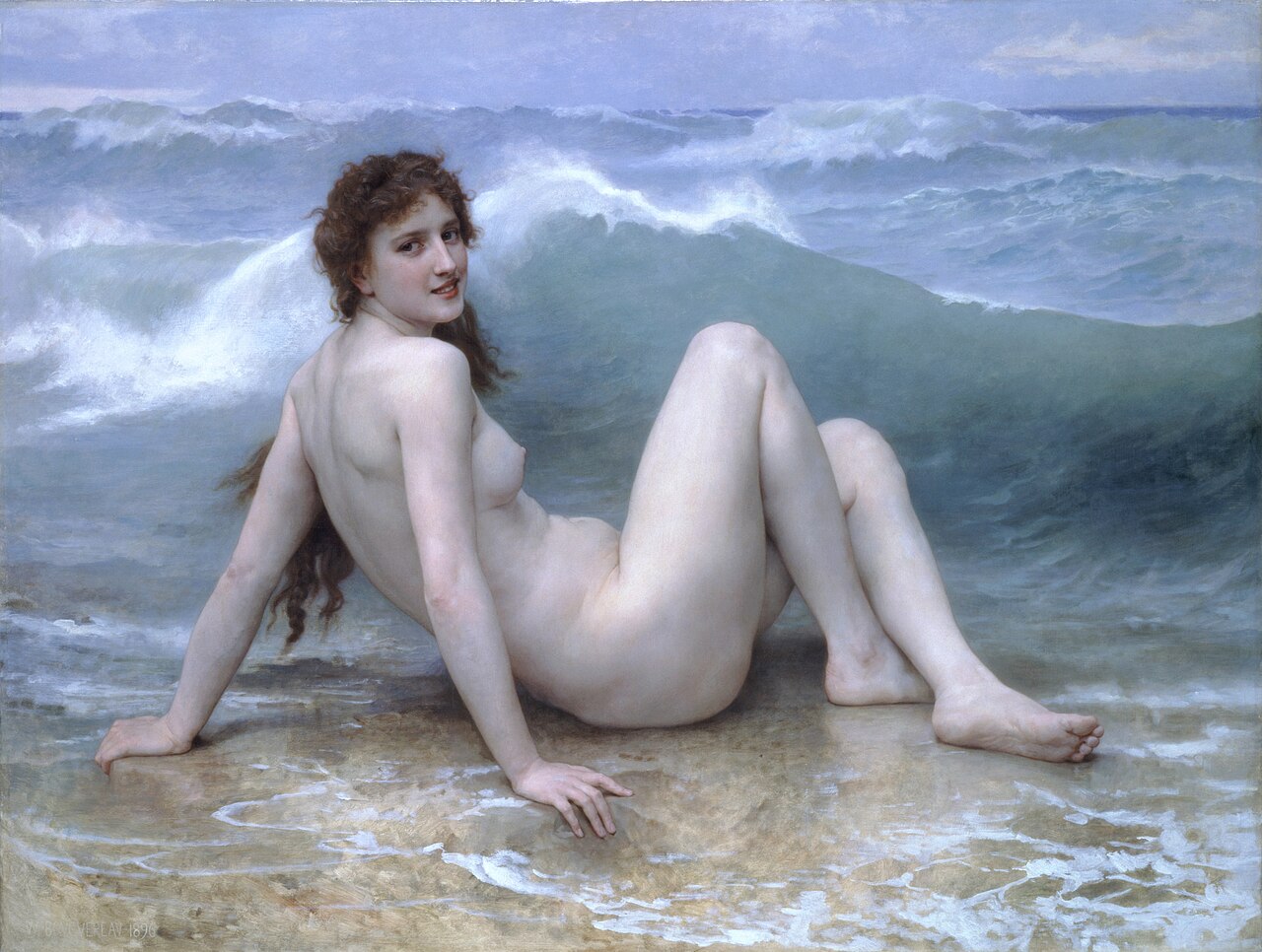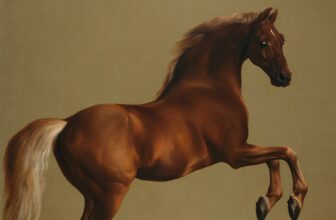
What is Meaning of The Wave Painting by Bouguereau
The Wave is an Academic-style, oil-on-canvas painting measuring approximately 121 x 160.5 cm, currently held in a private collection.
Set on a windswept beach, a single nude woman sits poised on a near-submerged rock. Behind her, a powerful wave rises just before its crest crashes ashore. Her expression is serene yet slightly playful, turning toward the viewer with a subtle half‑smile. Nearby, a simple folded towel lies, a still‑life reminder amid the dynamic sea. The entire scene captures a moment frozen between calm and storm, innocence and latent energy.
2. Who painted it, and how was it created?
William‑Adolphe Bouguereau (1825–1905), a celebrated French academic painter, was known for dazzling realism, meticulous technique, and idealized figures. A Prix de Rome winner, he rose to fame painting classical mythological and allegorical scenes with female nudes, a favorite of wealthy patrons until Impressionists rejected his style .
The year 1896 marks The Wave, signed “W BOUGUEREAU 1896” on the lower-left. Bouguereau likely began with pencil sketches and preparatory oil studies to perfect the figure and form, common practice for him. He painted directly from life: the model, perhaps Odile Charpentier, sits on a beach or makeshift coastal set, there are two known studies as evidence. His mastery is evident in the polished flesh, translucent skin tones, and vibrant wave study.
He exhibited this at the prestigious Salon de Paris in 1896 . It was owned by Akram Ojjeh at one point, then auctioned in 1999 for over $700,000, vastly surpassing its estimated guide of $250–350K reproduction-
What type of art is The Wave Painting
The Wave is a masterpiece of Academic art (also called French Academicism), rooted in Neoclassicism and Realism: a highly polished technique, classical ideal forms, and mythic themes . As a “nude painting,” it blends timeless aesthetic harmony with a hint of erotic allure. Drenched in light and clarity, it reflects Bouguereau’s devotion to idealized naturalism, a hallmark of salon painting.
What is happening in the painting?
The Shape of the Pose: The woman’s seated posture echoes classical figures, perhaps river goddesses or naiads, offering a sense of calm before the sea’s burst.
Tension of Moments: She sits on what looks like a submerged rock or table top, as one viewer cheekily noted, “the table has become a rock just below the water’s surface”
Juxtaposition: The serene figure contrasts with the restless sea behind her. The breaking wave, down to the spray, is rendered with delicate precision, hinting at nature’s power.
Viewer Engagement: Her turning gaze, the slight smile, invites participation and complicity. Is she calmly anticipating the wave? Or playfully diverting our attention?
Symbolic Still-life: The towel beside her evokes modesty and hints that she may have just bathed, tying into classical themes of transformation, purity, and innocence.
Analysis of Style and Technique
Technical Mastery: Flesh and muscle are softly modeled; light and shadow flow seamlessly. Bouguereau’s technical brilliance is unparalleled.
Brushwork & Contrasts: The smooth human form contrasts the energy of the wave. The rapid, feathery strokes in the foam capture movement, while smoother strokes render the skin’s softness.
Palette: Whites, creams, mild pinks, and subtle blues harmonize the human and aquatic worlds, highlighting a luminous meeting of flesh and water.
Composition: The canvas draws a visual arc: the figure transitions to the wave, cresting at the top. Bouguereau creates tension within graceful balance.
Symbolism & Meaning
Although not explicitly mythological, The Wave brims with symbolism:
Nature’s Power vs. Human Tranquility: The looming wave symbolizes nature’s unpredictability contrasted with the human calm.
Femininity & Sensuality: A nude woman by the sea is a recurring classical motif, suggesting fertility, transformation, and beauty.
Innocence & Foreboding: A youthful face and towel imply modesty, while the wave suggests a loss of innocence, an allegorical threshold.
Threshold Moments: The seaside is a transitional space; she sits on the border of two worlds. The wave poised to break may represent change, awakening, or emotional revelation.
Italian critic Louise d’Argencourt admired it: “there is realism in the modelling… skin and muscles painted so precisely as to reveal the model’s age”. This realism furthers the contrast between ideal and real, beauty rooted in truth.
Historical & Artistic Context
Bouguereau painted The Wave during the decline of Salon Academicism against the rising tide of French Impressionists. His academic style was increasingly unfashionable yet highly prized by wealthy collectors.
Contextual waves:
Much earlier, Hokusai’s Great Wave off Kanagawa (1830s) had reshaped perceptions of marine subjects
Courbet’s raw realism of 1869 onward also influenced marine paintings
Bouguereau, however, blended his waves into academic refinement and neoclassical poise.
Provenance & Location
Painted in France in 1896 reproduction, it debuted at the Salon de Paris. later owned by Akram Ojjeh, then sold at auction in 1999 for $700K+ reproduction. Its current owner remains private. Two preliminary studies still exist in private collections .
Cultural Impact
Though overshadowed by Impressionists and Modernists, Bouguereau enjoyed a late 20th-century revival. His technical artistry is now being reassessed, influencing contemporary realist painters .
The Wave, with its blend of technical mastery and allegorical richness, continues drawing admirers, visible in high-quality prints and hand-painted reproductions offered online . Its Instagram-ready beauty and narrative depth have cemented its place in 19th-century art.
Why It Matters
Technical Brilliance: It’s a lesson in rendering, light, and anatomy.
Narrative Complexity: A single scene communicates themes of innocence, power, and vulnerability, encouraging varied interpretations.
Historical Insight: It shows academic realism at its peak, in dialogue with modern artistic change.
Visual Splendor: The serene female form set against the dramatic natural world is timelessly compelling.
The Wave stands as one of Bouguereau’s signature works, an elegant fusion of classical mythology, masterful realism, and emotional intimacy. More than a pretty pastoral scene, it’s a meditation on thresholds, between water and land, calm and chaos, innocence and awakening.
From its Salon debut to its late-20th-century rediscovery, it remains a touchstone for lovers of Academic realism. In Bouguereau’s brushstroke, water and flesh share an inspired harmony, an invitation to pause and reflect on timeless balance.




